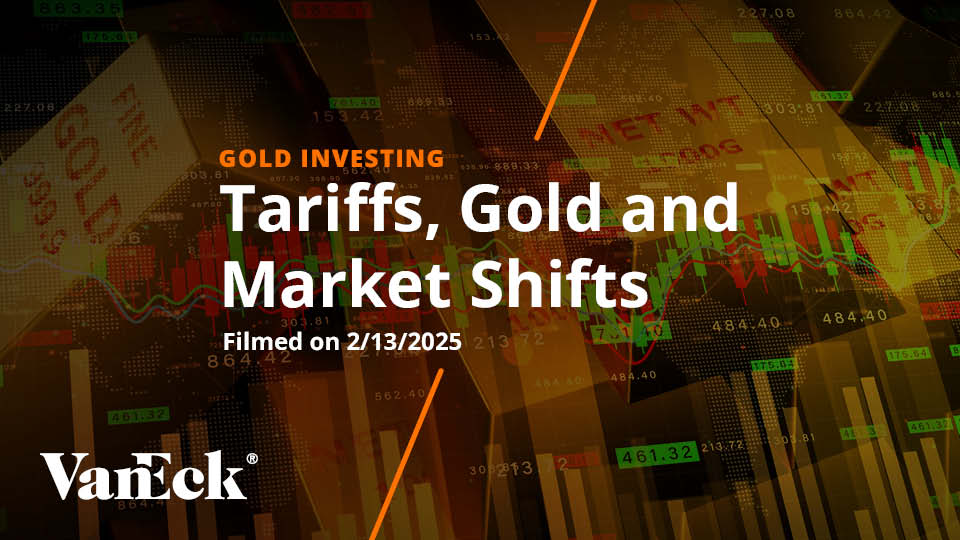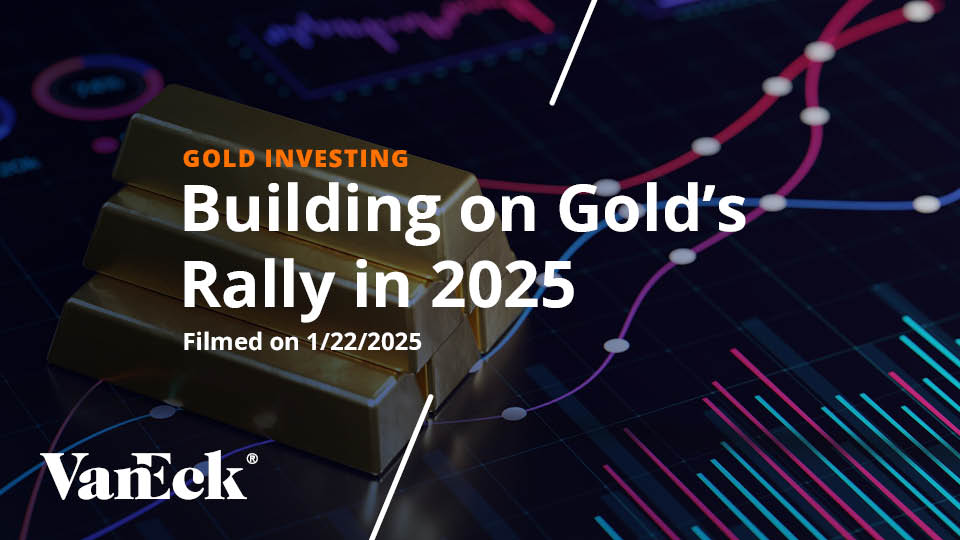Gold Price & Investment Outlook: 2024 & Beyond
12 September 2024
Read Time 8 MIN
Gold is one of the most vital metals in the world and a unique asset, with the ability to enhance portfolio diversification, act as store of value, and hedge against systemic risk. VanEck has long been considered a leader in gold-related investments and has been managing gold funds since 1968, including the nation’s first open-ended gold equity mutual fund.
As we look to the future of gold investment, understanding the evolving dynamics and fundamentals of this precious metal is crucial. This article will provide a recap of the current state of gold investing, some of VanEck’s gold market predictions, and the Firm’s general outlook for the metal in the coming years.
Recent Trends in Gold Investing
In 2024, gold prices have soared to record highs, reaching $2,409 per ounce. This surge has been driven, in part, by robust central bank demand—including from emerging markets such as China, India, and Turkey.
Gold prices are significantly influenced by global economic conditions, including inflation rates and geopolitical tensions. Despite the Federal Reserve's more restrictive monetary policy, gold has continued its upward trajectory, suggesting strong underlying demand and investor confidence in gold as a safe haven asset.
Historically, gold has reacted to various global events such as financial crises and shifts in monetary policy. The current trend mirrors past periods where gold strengthened amid global uncertainties, suggesting a recurring pattern of investor behavior during times of economic stress.
Historical Lookback of Gold Prices
For centuries, gold has served as a form of exchange, a safe haven investment (in times of financial market turmoil) as well as a hedge against severe inflation. As an investment, gold helps enhance portfolio diversification, acts as store of value, and offers a hedge against systemic risk. In addition, gold has outperformed traditional asset classes over the last 20 years.
Gold Outperformance Over 20 Years: 2000 - 2024
Source: FactSet, VanEck. Data as of March 2023. U.S. Stocks represented by S&P® 500 Index; U.S.Bonds represented by Bloomberg Barclays U.S. Aggregate Bond Index; Gold ($/oz) represented by LBMA PM Gold Price; U.S. Treasuries represented by the Bloomberg Barclays U.S. 1-3 Year Treasury Bond Index.
Key Factors Affecting Gold Prices
Understanding the macroeconomic, geopolitical, and technological factors that influence the price of gold is crucial for investors seeking to navigate the complexities of the market. The impact of interest rates and global economic policies collectively shape the investment landscape of gold.
Macroeconomic Factors Affecting Gold Prices
Interest rates are a primary macroeconomic factor affecting gold. Typically, higher rates decrease gold's attractiveness since gold yields no interest. However, current trends deviate from this norm due to sustained inflationary pressures and economic uncertainties, maintaining strong investment demand for gold.
Looking forward, the anticipation of rate cuts by the Federal Reserve, along with continued inflationary pressures and geopolitical risks, are likely to further bolster gold's appeal as a hedge against market volatility.
Geopolitical Influences
Historical data shows that gold prices often increase during times of geopolitical unrest or instability, as investors seek stability. This sensitivity to global political dynamics contributes to gold's status as a “safe haven” asset.
Recently, massive purchases by emerging market central banks (particularly China, India and Turkey) are helping to sustain gold prices, even as more traditional drivers of demand have lagged.
Gold Investing Outlook and Why Gold Could Go Higher in 2024
Here we explore what these developments could mean for gold prices in 2024 and beyond, examining both short-term forecasts and longer-term projections based on current and emerging market influences.
Short-term Forecast: 2024 Gold Predictions
We believe gold has the potential to trade in a higher range in 2024. In recent years, strong rallies, such as the one gold has recently been enjoying, have often been followed by periods of consolidation around an established, higher level, with the metal trading in a sideways pattern until a new catalyst emerges to drive prices even higher.
Looking forward, gold is well positioned to continue its rally, especially if Western investors begin to return to the market. The anticipation of rate cuts by the Federal Reserve, along with continued inflationary pressures and geopolitical risks, are likely to further bolster gold's appeal as a hedge against market volatility. With this backdrop, we believe that gold prices could reach their inflation-adjusted highs of $2,800 per ounce in the near term.
Side Note: For Miners, It’s About More Than Just the Gold Price
A rising gold price environment has historically been accompanied by strong performance by gold equities. The sector outperformers must also demonstrate that they are fundamentally positioned and have a sound strategy that will translate higher gold prices into improved cash flow and higher returns, which will deliver growth. Organic growth does not come easy in the gold sector. Finding new gold deposits, or defining/expanding existing ones, is a difficult, lengthy, and capital-intensive process. Most senior and mid-tier companies struggle to simply replace their annual production. To significantly expand their depleting reserve and resource base, companies generally must acquire other companies or assets. All things equal, the more advanced a project is, the higher its valuation and the faster the company can deliver growth.
5 Year Forecast: Gold Price Forecast for 2025-2029
In the current market environment, gold prices are hitting all-time highs despite outflows from U.S. gold bullion ETFs. As VanEck’s CEO recently noted, gold prices aren’t just rallying in a small way. They are reaching, bitcoin-like, for the sky. For insights on the medium-term outlook for gold, investors should pay close attention to broader inflation and government spending trends.
The three major macro factors—monetary policy, government spending and global economic growth—are not expected to change much in 2024. Looking past 2024, gold is signaling that government spending policy could be significantly stimulative.
That said, the outlook for gold prices over the next five years varies. Some research sets the upside for gold prices at levels as high as $3,000 per ounce, which would represent an increase of more than 25% from current levels. On the flip side, the potential floor of gold prices is in a range between $1,850 and $2,000 an ounce, which represents a significant percentage decrease from its current price range.
Long-term Gold Forecast: 2030 & Beyond
Longer term, investors should expect gold to continue to act as a hedge against broader market volatility and uncertainty. Since 2008, gold has outperformed U.S. stocks and Treasuries during the most notable of market crises. This reflects gold’s role as a hedge against financial risks and safe haven amid uncertainty. Some of VanEck’s own experts suggest that the case for gold may grow stronger due to the U.S. dollar’s reserve status potential decline, and emerging market central bank’s gold holdings continue to rise.
Conclusion: Investing in Gold a Cornerstone of a Diversified Portfolio
Gold continues to be an indispensable asset in the global financial landscape, demonstrating remarkable resilience and adaptability amidst fluctuating macroeconomic conditions and geopolitical tensions. Throughout 2024, gold prices have reached new highs, driven by a mix of robust investment demand and substantial buying from emerging market central banks. This trend underscores gold's enduring role as a safe haven during times of economic uncertainty and its appeal as a hedge against systemic risks and inflation.
Looking ahead, the investment outlook for gold remains positive, with expectations of continued strength in the market. Factors such as potential rate cuts by the Federal Reserve, ongoing geopolitical risks, and sustained inflationary pressures are likely to further enhance gold's attractiveness. Additionally, technological advancements in mining and shifts in consumer demand in industries like electronics and jewelry will continue to influence gold production and prices.
For investors, the strategic implications are clear: gold should be considered a vital component of a diversified investment portfolio, not only for its traditional benefits but also for its potential to deliver significant returns in a complex global economic environment. The insights provided here aim to equip investors with the knowledge to navigate the evolving gold market, ensuring informed decision-making for both short-term opportunities and long-term investment strategies.
VanEck has provided investors access to gold, one of the most vital metals in the world, for over 50 years with both actively and passively managed solutions.
Related Insights
IMPORTANT DEFINITIONS & DISCLOSURES
This material may only be used outside of the United States.
This is not an offer to buy or sell, or a recommendation of any offer to buy or sell any of the securities mentioned herein. Fund holdings will vary. For a complete list of holdings in VanEck Mutual Funds and VanEck ETFs, please visit our website at www.vaneck.com.
The information presented does not involve the rendering of personalized investment, financial, legal, or tax advice. Certain statements contained herein may constitute projections, forecasts and other forward looking statements, which do not reflect actual results. Information provided by third-party sources are believed to be reliable and have not been independently verified for accuracy or completeness and cannot be guaranteed. Any opinions, projections, forecasts, and forward-looking statements presented herein are valid as of the date of this communication and are subject to change without notice. The information herein represents the opinion of the author(s), but not necessarily those of VanEck.
The views contained herein are not to be taken as advice or a recommendation to buy or sell any investment in any jurisdiction, nor is it a commitment from Van Eck Associates Corporation or its subsidiaries to participate in any transactions in any companies mentioned herein. This content is published in the United States. Investors are subject to securities and tax regulations within their applicable jurisdictions that are not addressed herein.
All investing is subject to risk, including the possible loss of the money you invest. As with any investment strategy, there is no guarantee that investment objectives will be met and investors may lose money. Diversification does not ensure a profit or protect against a loss in a declining market. Past performance is no guarantee of future results.


